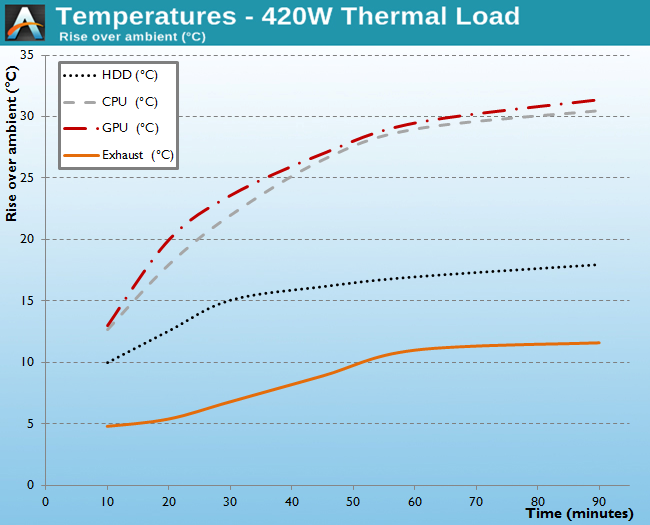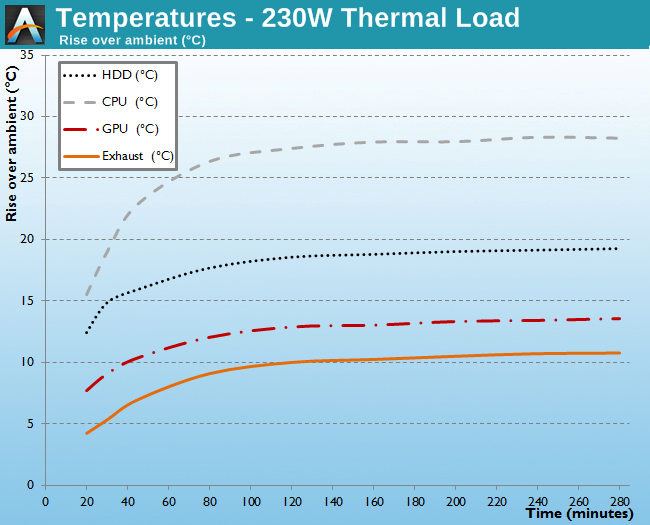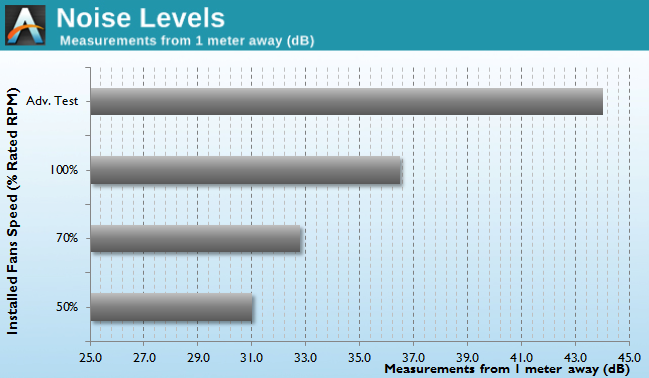Corsair Carbide Air 240 Case Review
by E. Fylladitakis on August 15, 2014 6:00 AM EST- Posted in
- Cases/Cooling/PSUs
- Corsair
- ATX
- Case
- Carbide
Test Setup
Professional testing requires the emulation of real-world situations but with repeatable results; thus, a perfectly controllable test setup and environment are required, especially for comparable results. Testing the thermal performance of any case with a typical real-world setup technically limits the comparability of the results to this setup alone, as an active system interacts with its environment and the change of a single component would alter myriads of variables. For our case reviews, we developed synthetic loads that emulate the thermal output of real systems, but these are passive, steady and quantifiable loads. This allows us to test the thermal capabilities of the case alone, as if it would have to deal with the entire thermal load by itself, regardless of what system an end user might install in it.
Laboratory data loggers are used to monitor the PT100 sensors and control the safety relays, which are fully accessible via our custom software. We have created three such loads, and we'll use the Micro-ATX load for this case. The Micro-ATX version simulates a 180W CPU, 40W VRM, 20W RAM, and 1 × 120W GPU card thermal load. Finally, two 3.5" HDD dummy loads have also been installed, with each of them converting 30W of electrical power to thermal. Note that the total load is generally more important than the individual elements, and the total thermal load of the Micro-ATX test setup is up to 420 Watts. As such, the thermal load is very high and only the best of cases will be able to handle it for more than a few minutes. For comparison purposes, we are also performing a test with a thermal load of 230W by reducing the CPU load to 90W, removing one disk load and using a low-profile, 50W version GFX load.
Thermal testing is performed with all of the case's stock fans operating at maximum speed. Standard noise testing has been performed with a background noise level of 30.4dB(A). Advanced noise testing is also being performed, in order to assess the ability of the case to dampen the noise of the components installed inside it. This includes the installation of two noise-generating sources (strong fans) inside the case, one positioned approximately over the first expansion slot and one over the CPU area, which generate ≈ 44.2 dB(A) when unobstructed. During the advanced noise test, all stock cooling options of the case are disabled.
Results and Discussion
As we expected from a case designed for ventilation, and despite its relatively compact size, the Carbide Air 240 displays exceptional thermal performance, significantly superior to that of the Mini-ITX Obsidian 250D. Although a direct comparison is not really possible, as the GPU load we use to test ATX cases is much higher, it would appear that the Carbide Air 240 has little to be jealous of Midi-ATX cases as well, delivering CPU and HDD temperatures that can easily rival cases such as the XFX Bravo 01 and Corsair's own Obsidian 450D.
The three stock cooling fans of the Carbide Air 240 are fairly weak, but that also has a positive effect on the acoustic performance of the case. With only the stock cooling fans installed, the Carbide Air 240 is a relatively quiet system, which can be made entirely quiet by simply connecting the fans onto the motherboard headers and leaving their speed control up to the BIOS. However, due to its design, the Carbide Air 240 cannot dampen the noise of the components installed inside it. Our testing revealed nearly zero noise-dampening capabilities, which is true of any case with so many openings on all sides.













63 Comments
View All Comments
kyuu - Friday, August 15, 2014 - link
I love the Carbide Air 540, and have been planning on using it for my next build (or perhaps just transplanting my current one, since I've yet to feel compelled to upgrade my overclocked Sandy Bridge system). The idea of a smaller one is great, since the relative girth of the 540 is one of its only drawbacks, as far as I'm concerned.However, the fact that you can't fit radiators unless you go down to a mini-ITX mobo, which only have one PCIe slot I believe, kind of kills it. They also really should have found a way to add a slimline optical drive slot.
Antronman - Friday, August 15, 2014 - link
No 5.25" inch drive bay?I mean, you can't find any room for anywhere in there?
Grok42 - Saturday, August 16, 2014 - link
If they do find room, I hope they add more 3.5" or 2.5" internal bays.notlurking - Sunday, August 17, 2014 - link
Why would you need a few more 3.5" bays? That's what a NAS is for. The Air 540 looks like a great NAS case from the outside but needs a serious redesign on the inside to make it useful in that function.I don't know what Corsair was thinking. There is so much empty space in that case. It looks great on the outside but doesn't work on the inside for any specific role.
DanNeely - Sunday, August 17, 2014 - link
They might be able to fit a slimline above the front fans. Maybe not, it'd be tight due to the 45* bevel on the top edge. The only way they could get a full size bay in without making the case bigger would be to put it in vertically below the 2.5" bays (and shift the front panel connectors around). It'd work for fan controllers or optical drives there; but probably not bay reservoirs. OTOH you could shoehorn in a small non-bay res into that space now.ImSpartacus - Friday, August 15, 2014 - link
It's 2014, why do those graphs have gradient backgrounds?If this was a middle schooler's first powerpoint, then I'd be forgiving. Nope, it's a modern tech blog's technical presentation.
You don't have to have 100% flat diagrams, but a little minimalism could go a long way.
juhatus - Saturday, August 16, 2014 - link
Thanks for great article, again! Few comment:Please post the component listing you used for this? Would be great starting point for build.
Also please post on conclusion what are the main competitors (even few examples) for this case. I´m right about to order something like this with mini-itx, Z97 and 4790k. I´m kind of liking Cooler Master 130 but it would need to be white so no go. I am having really hard time deciding what case to go for :)
know of fence - Saturday, August 16, 2014 - link
A picture with the cooler mounted would be appreciated.People, please stop buying these double shoe-box form factors and closed loop water coolers. Both are inferior alternatives to what is out there: real men buy towers and tower coolers.
This whole market segment exists because people try to be cute and think "out-of-the-box" making the same mistake, but some alternatives just aren't worth considering. A PC goes on the floor where it's least in the way and furthest from one's ears, this thing you could put on a shelf, but wouldn't you rather have the shelf space?
kyuu - Saturday, August 16, 2014 - link
CLC coolers are a perfectly good alternative to giant, heavy air tower coolers. They're also really, really good for cooling GPUs. I'm planning on using a CLC on both my CPU and GPU for my next build.Towers are fine, but cubes work well too, and having two separate compartments for the components like the Air makes a lot of sense. It's also a helluva lot easier to assemble. The 240 is too small, though, unless you're fine with mini-ITX. Have to go with the 540.
juhatus - Sunday, August 17, 2014 - link
If you ask the miss, than you should be buying a ultrabook of the size 11", or why not just buy an IPAD. These are harsh realities some men live. So its mini-itx or ipad, you choose.Ill take mini-itx.